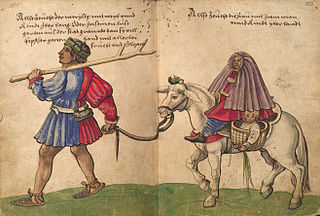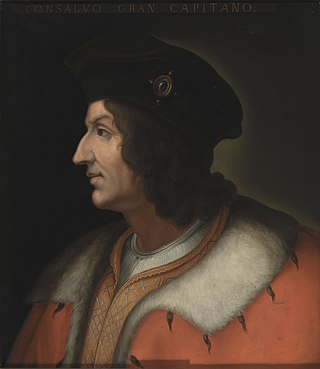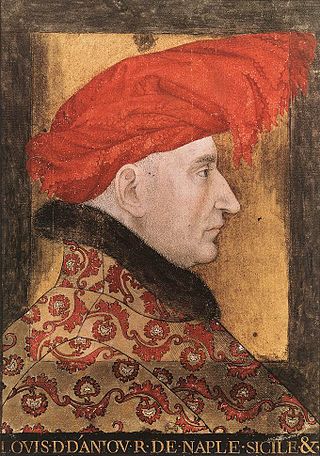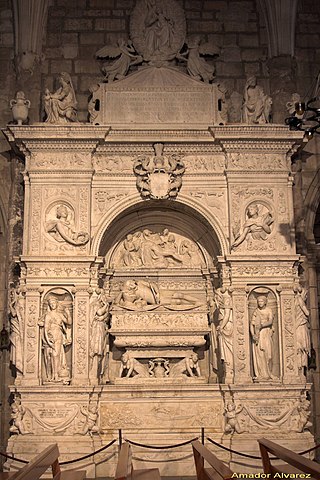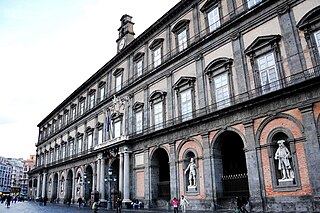
This is a list of viceroys of the Kingdom of Naples . Following the conquest of Naples by Louis XII of France in 1501, Naples was subject to the rule of the foreign rulers, first for a short time by the King of France and later by Spain and the Habsburg Archdukes of Austria respectively. Commonly staying far from Naples, these rulers governed the Kingdom through a series of viceroys.
| Name | Reign | Notes | |
|---|---|---|---|
| French rule (1501–1504) | |||
| Louis of Armagnac, Duke of Nemours | 1501–1503 | Viceroy under King Louis XII of France. Fell in the Battle of Cerignola. | |
| Ludovico II, Marquess of Saluzzo | 1503–1504 | Viceroy of Naples under King Louis XII of France | |
| Under the Crown of Aragon (1504–1707) | |||
| Gonzalo Fernández de Córdoba (1453–1515) | 1504–1507 | Viceroy under King Ferdinand III. | |
| Juan de Aragón y de Jonqueras, 2nd count of Ribagorza | 1507–1509 | ||
| Antonio de Guevara | 1509 | Viceroy under King Ferdinand III | |
| Ramón de Cardona | 1509–1511 | Viceroy of Sicily under King Ferdinand III | |
| Cardinal Francisco de Remolins | 1511–1513 | Viceroy under King Ferdinand III and Pope Julius II (papal fief) | |
| Ramón de Cardona | 1513–1522 | Viceroy under King Ferdinand III | |
| Charles de Lannoy, | 1522–1523 | under Charles V. | |
| Andrea Carafa | 1523-1526 | under Charles V | |
| Ludovico Montalto | 1526-1527 | under Charles V | |
| Hugo of Moncada | 1527 – May 1528 | Viceroy of Sicily, 1509–1517, under King Ferdinand II of Aragon, Viceroy of Naples, 1527–1528, Charles V | |
| Philibert of Châlon | 1528–3 August 1530 | Viceroy under Charles V. | |
| Pompeo Colonna | 1530–1532 | Viceroy under Charles V | |
| Pedro Álvarez de Toledo | 1532–1553 | Viceroy under Charles V | |
| Luis Álvarez de Toledo y Osorio | February – May 1553 | Lieutenant-General under Charles V. Succeeded his father Pedro when he retired due to illness. | |
| Pedro Pacheco Ladrón de Guevara | 1553–1556 | Viceroy under Charles V and Philip II of Spain. | |
| Fernando Álvarez de Toledo | 1556–1558 | Governor of the Duchy of Milan, 1555–1556, Viceroy of Naples 1556 - 1557 under Philip II of Spain. | |
| Juan Fernandez Manrique de Lara | 6 June – 10 October 1558 | Viceroy of Catalonia, 1543–1554, under Charles V, Viceroy of Naples, June to October 1558, under King Philip II of Spain. | |
| Pedro Afán de Ribera | 1559–1571 | Viceroy of Catalonia, 1554–1558, Viceroy of Naples 1559–1571, under King Philip II of Spain. | |
| Antoine Perrenot de Granvelle | 1571–1575 | Viceroy under King Philip II of Spain. | |
| Íñigo López de Mendoza y Mendoza | 1575–1579 | Viceroy of Valencia, 1572–1575, Viceroy of Naples under King Philip II of Spain. | |
| Juan de Zúñiga y Requesens | 1579–1582 | Viceroy under King Philip II of Spain. | |
| Pedro Girón, 1st Duke of Osuna | 1582–1586 | Viceroy of Naples under King Philip II of Spain. | |
| Juan de Zúñiga y Avellaneda | 1586–1595 | Viceroy under King Philip II of Spain. Also Viceroy of Catalonia, 1583–1586 and 1st Duke of Peñaranda de Duero. | |
| Enrique de Guzmán, 2nd Count of Olivares | 1595–1598 | Viceroy under King Philip II of Spain | |
| Fernando Ruiz de Castro Andrade y Portugal | 1599–1601 | Viceroy under King Philip III of Spain. | |
| Francisco Ruiz de Castro | 1601–1603 | Viceroy under King Philip III of Spain. | |
| Juan Alonso Pimentel de Herrera, 5th Duke of Benavente | 1603–1610 | Viceroy of Valencia, 1598–1602, Viceroy of Naples, 1603–1610, under King Philip III of Spain. | |
| Pedro Fernández de Castro Andrade y Portugal | 1610–1616 | Viceroy under King Philip III of Spain. | |
| Pedro Téllez-Girón, 3rd Duke of Osuna | 1616–1620 | Viceroy under King Philip III of Spain. | |
| Gaspar Cardinal Borgia | June – December 1620 | Archbishop of Seville, February 1632 – January 1645, Archbishop of Toledo 1645, Lieutenant-General of Naples under King Philip III of Spain. | |
| Antonio Zapata y Cisneros | December 1620 – December 1622 | Inquisitor-general of Spain, 1627–1632. Lieutenant-General under Kings Philip III and Philip IV of Spain | |
| Antonio Álvarez de Toledo, 5th Duke of Alba | 1622–1629 | Knight of the Order of the Golden Fleece, 1599. Viceroy under King Philip IV of Spain | |
| Fernando Afán de Ribera y Téllez-Girón | 1629–1631 | Viceroy under King Philip IV of Spain. | |
| Manuel de Acevedo y Zúñiga | 1631–1637 | Viceroy under King Philip IV of Spain. | |
| Ramiro Núñez de Guzmán | 1637–1644 | Viceroy under King Philip IV of Spain. He was the son in law, since 1625, of the Spanish PM Gaspar de Guzmán, Count-Duke of Olivares | |
| Juan Alfonso Enríquez de Cabrera | 1644–1646 | Viceroy of Sicily, 1641–1644, Viceroy of Naples under King Philip IV of Spain | |
| Rodrigo Ponce de León, 4th Duke of Arcos | 1646–1648 | Viceroy of Valencia, 1642–1645. Under his rule the "Neapolitan Republic" rebellion by Masaniello broke out | |
| John of Austria | January 1648 – March 1648 | Viceroy under King Philip IV of Spain, bastard son of the ruling Spanish King, sent to Naples to crush the Neapolitan Revolt. | |
| Íñigo Vélez de Guevara, 8th Count of Oñate | 1648–1653 | Head of the Imperial Post Office Services, Viceroy of Naples under King Philip IV of Spain. | |
| García de Haro-Sotomayor y Guzmán | 1654–1659 | President of the Council of Italy,[ citation needed ] Viceroy under King Philip IV of Spain.[ citation needed ] | |
| Gaspar de Bracamonte, 3rd Count of Peñaranda | 1659–1664 | Viceroy under King Philip IV of Spain | |
| Pascual Cardinal de Aragon | 1664–1666 | Viceroy under Kings Philip IV and Charles II of Spain | |
| Pedro Antonio de Aragón | 1666–1671 | Viceroy under King Charles II of Spain | |
| Fadrique Alvarez de Toledo y Ponce de León | 1671–1672 | Viceroy of Sicily, 1673–1676, Lieutenant-General under King Charles II of Spain. Knight of the Order of the Holy Spirit, France, 1703. | |
| Antonio Pedro Sancho Dávila y Osorio | 1672–1675 | Viceroy under King Charles II of Spain | |
| Fernando Joaquín Fajardo de Requeséns y Zúñiga, 6th Marquis of Los Velez | 1675–1683 | Viceroy under King Charles II of Spain | |
| Gaspar Méndez de Haro, 7th Marquis of Carpio | 1683–1687 | Viceroy under King Charles II of Spain | |
| Francisco de Benavides | 1687–1696 | Viceroy under King Charles II of Spain | |
| Luis Francisco de la Cerda y Aragón | 1696–1702 | Viceroy under Kings Charles II of Spain and Philip V of Spain | |
| Juan Manuel Fernández Pacheco, 8th Marquis of Villena | 1702–1707 | Viceroy of Navarre, 1691–1692, Viceroy of Aragón, 1693, Viceroy of Catalonia, 1693–1694, Viceroy of Sicily, 1701–1702, 1st Director of the Royal Spanish Academy, 1713–1725. Knight of the Order of the Golden Fleece, 1687. Viceroy under King Philip V of Spain from 1702 onwards. | |
| Austrian rule (1707–1734) | |||
| Georg Adam von Martinitz | July – October 1707 | Viceroy under King Joseph I. | |
| Wirich Philipp von Daun | 1707–1708 (first time) | 1724: Governor of the Austrian Netherlands, formerly Spanish Netherlands, Governor of Milan, 1728–1733. Viceroy of Naples under King Joseph I. | |
| Vincenzo Grimani | 1708–1710 | Viceroy under King Joseph I. | |
| Carlo Borromeo Arese | 1710–1713 | Viceroy under King Joseph I and under King Charles VI. | |
| Wirich Philipp von Daun | 1713–1719 (second time) | Viceroy under King Charles VI, 2nd time. | |
| Johann Wenzel Count of Gallas | July 1719 | Viceroy under King Charles VI | |
| Wolfgang Hannibal Count of Schrattenbach | 1719–1721 | Viceroy under King Charles VI | |
| Marcantonio Borghese, 3rd Prince of Sulmona | 1721–1722 | Viceroy of Naples under King Charles VI | |
| Michael Friedrich von Althan | 1722–1728 | Viceroy under King Charles VI. Anti-Austrian rioting breaks out in Naples, 1723. | |
| Joaquín Fernández de Portocarrero | July – December 1728 | Viceroy of Naples and also Viceroy of Sicily, 1722–1728, under King Charles VI. | |
| Aloys Thomas Raimund Count of Harrach | 1728–1733 | Viceroy under King Charles VI. | |
| Giulio Visconti Borromeo Arese, conte di Brebbia | 1733–1734 | In 1707 he had been awarded a Grandee of Spain title, 2nd class, by Philip V of Spain. Viceroy under King Charles VI. | |


